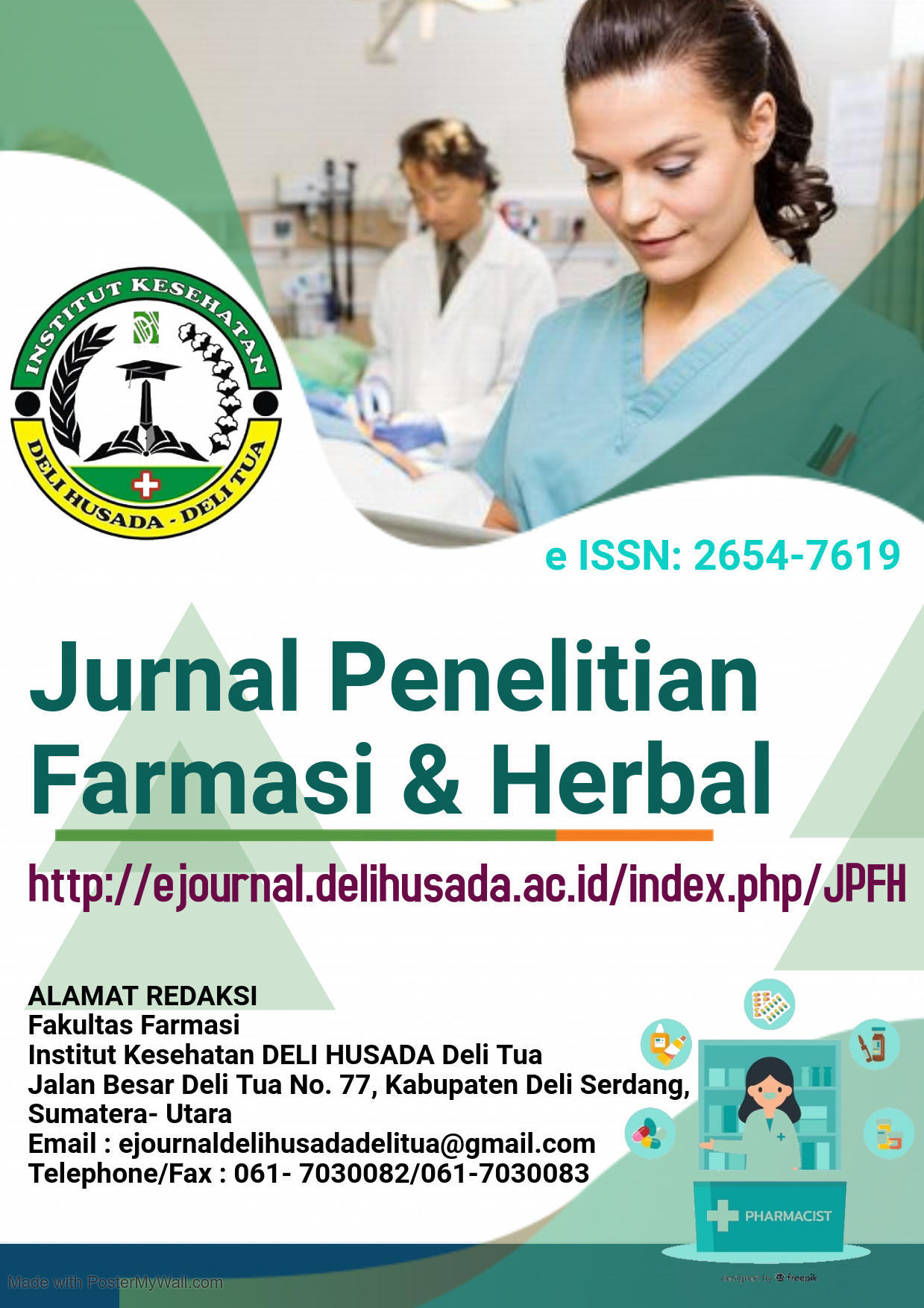FORMULATION OF OINTMENT OF ANTIBACTERY ETHANOL EXTRACT OF TORCH GINGER (Etlingera elatior) AGAINST BACTERIA STAPHYLOCOCCUS AUREUS
Abstract
One of the causes of infection was bacteria, such as Staphylococcus aureus. Torch ginger has been widely used to treat dwaseases caused by bacteria. Torch ginger has been studied to have antibacterial activity against Staphylococcus aureus bacteria. The purpose of thwas study was to formulate an ointment preparation of ethanol extract of torch ginger and to see if the ointment preparations had antibacterial activity against Staphylococcus aureus bacteria. The research method used in thwas research was experimental True, covering the stages: making of ethanol extract of kecombrang flower with maceration method using 96% ethanol solvent, ointment formulation made with ointment base: vaseline, adeps lanae, and propylene glycol. Made in three concentrations of extracts namely: F I with 100 mg, F II with 200 mg, and F III with 300 mg. Furthermore, the evaluation of the preparation of evaluation of physical stability and homogeneity, and test of antibacterial activity against Staphylococcus aureus bacteria with diffusion method to use Kirby odor dwasc paper. The results showed that the ointment had good physical stability and homogeneity for 30 days of storage at room temperature. The antibacterial activity test of the ointment shows that the inhibitory diameter F I has an average of 16.45 mm, F II has an average of 18.60 mm and F III has an average of 21.12 mm. Based on the results obtained it can be concluded that the preparation of the ethanol extract of torch ginger has an inhibitory power to Staphylococcus aureus bacteria. In the next research was expected to pay attention to the growing area of torch ginger and to compare the antibacterial activity between petal flowers and flower seeds using Staphylococcus aureus bacteria.
Downloads
References
Anief, M. (2007). Farmasetika. Yogyakarta: UGM Press. Halaman 59
Depkes RI. (1995). Materia Medika Indonesia. Jilid VI. Cetakan VI. Jakarta: Direktorat Jendral Pengawasan Obat dan Makanan. Halaman 247-251, 199-304, 321-325.
Ditjen POM. (1978). Formularium Nasional. Edisi Kedua. Jakarta: Depkes RI. Halaman 66.
Ditjen POM. (1995). Farmakope Indonesia. Edisi Keempat. Jakarta: Departemen Kesehatan RI.
Jawetz, E., Joseph, M., Edward, A.A., Geo, F.B., Janet , S.B., dan Nicholas, L.D. (2001). Mikrobiologi Kedokteran. Penerjemah: Mudihardi, E., Kuntaman., Wasito, E.B., Mertamiasih, M., Harsono, S., dan Alimsardjono., L. Jakarta: Penerbit Salemba Medika.
Khildah, Ihwan. (2011). Uji Efek Antibakteri Ekstrak Etanol Herba Seledri Terhadap Escherchia coli dan Staphylococcus aureus dan Analisis KLT Bioautografi. Jurnal Biocebeles. Sulawesi Tengah, Vol 5 No 1.
Lubis, Muhhidin,. (2014). Formulasi Salep Ekstrak Etanol Cacing Tanah dan Uji Aktifitasnya Terhadap Bakteri Staphylococcus aureus. Skripsi. Sumatera Utara: Jurusan Farmasi Universitas Sumatera Utara
Nasution, M. (2014). Pengantar Mikrobiologi. Medan: USU Press. Hal. 24-25, 28 76-78.
Naufalin, R. (2005). Kajian sifat Antimikroba Ekstrak Bunga Kecombrang (Nicolaia speciosa Horan) terhadap Berbagai Mikroba Patogen dan Perusak Pangan. Sekolah Pasca Sarjana. Institut Pertanian Bogor: Bogor.
Pardosi, Ferawati. (2012). Uji Aktivitas Antibakteri Minyak Atsiri Dan Ekstrak Etanol Dari Bunga Kecombrang (Nicolaia Speciosa Horan) Terhadap Bakteri Staphylococcus Epidermidis, Staphylococcus Aureus Dan Pseudomonas Aeruginosa. Skripsi Fakultas Farmasi. Universitas Sumatera Utara: Medan
Sumardi. (1998). Deteksi dan Karakterisasi Senyawa Antibiotik dari Ekstrak dan Isolat Mikroba Dalam Tubuh Cacing Tanah Allolobophora rosea. Tesis. Bogor: Jurusan Biologi Institut Pertanian Bogor
Wohlmuth, Hans. (2008). Phytochemistry and pharmacology of plants from the ginger family, Zingiberaceae. Theses. Southern Cross University
World Health Organization. (2002). Traditional Medicine Strategy.







